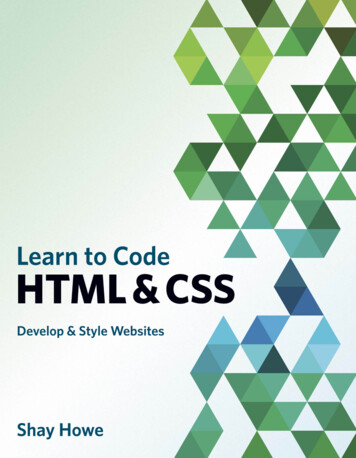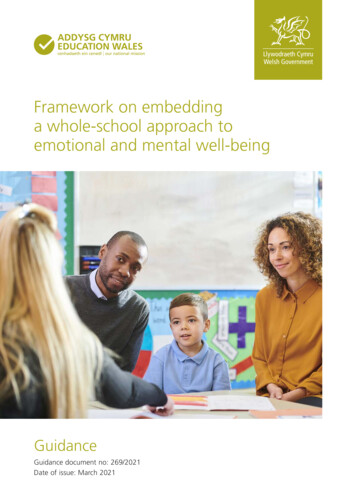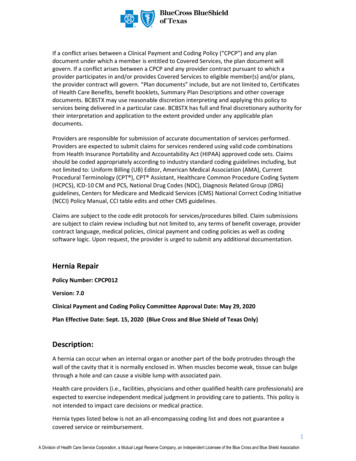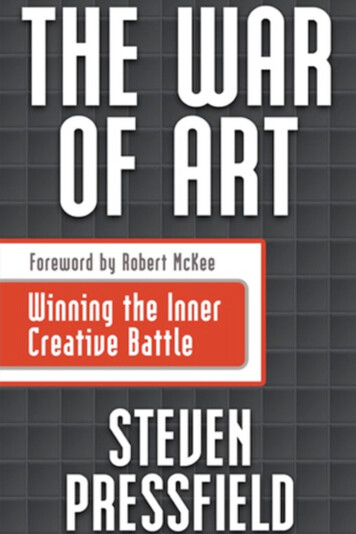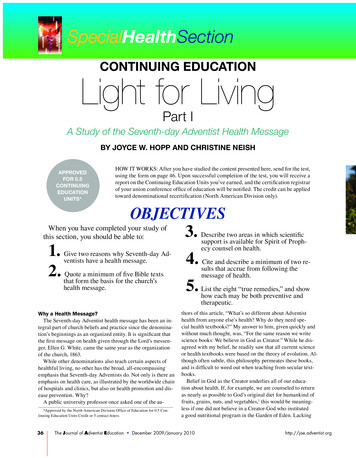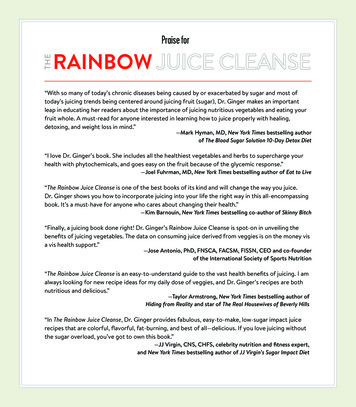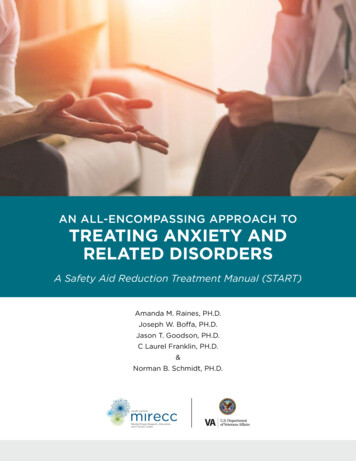
Transcription
AN ALL-ENCOMPASSING APPROACH TOTREATING ANXIETY ANDRELATED DISORDERSA Safety Aid Reduction Treatment Manual (START)Amanda M. Raines, PH.D.Joseph W. Boffa, PH.D.Jason T. Goodson, PH.D.C Laurel Franklin, PH.D.&Norman B. Schmidt, PH.D.
Published by the Department of Veterans Affairs (VA), South Central Mental IllnessResearch, Education and Clinical Center (MIRECC), 2021.The contents of this manual do not represent the views of the VA or the U.S. government.This manual was supported by a clinical educator grant from the VA South CentralMIRECC.Suggested Citation: Raines, A. M., Boffa, J. W., Goodson, J. T., Franklin, C. L., & Schmidt, N.B. (2021). An All-Encompassing Approach to Treating Anxiety and Related Disorders: ASafety Aid Reduction Treatment Manual.To request a copy of this manual please email VISN16SCMIRECCEducation@va.gov.For questions about this manual please contact Dr. Raines at Amanda.Raines@va.gov.2
ACKNOWLEDGMENTSThis manual, which is based on an unpublished treatment protocol developed by Schmidtand colleagues, stemmed from our interests in preventing and treating anxiety andrelated disorders, namely anxiety, depressive, obsessive-compulsive, and trauma- andstressor-related disorders. We are interested in the development and dissemination ofpsychotherapies that can be applied to individuals with multiple disorders or to mixeddiagnostic groups, as such protocols could overcome time and training barriers forclinicians within the VA and elsewhere. We would like to express our gratitude to theindividuals and organizations that supported this work. Specifically, we would like to thankthe following individuals who served as expert consultants providing content feedback onthe manual – Bunmi Olatunji, PhD; Frank Weathers, PhD; and Desirae Vidaurri, PhD – aswell as the following clinicians who reviewed the manual for clarity and ease of utilization– Chelsea Ennis, PhD, and Chandler Habig, LMSW. Additionally, we would like to thankthe graphic designer as well as those individuals who edited/formatted portions of themanual – Jessica Chambliss, MS, and Shelby McGrew, BS. Finally, we are grateful for thesupport of the VA and the funding provided by a clinical educator grant from the SouthCentral MIRECC. Without these individuals and resources, this product would not havebeen possible.3
CONTENTSBACKGROUND INFORMATION FOR CLINICIANS5CHAPTER 1: SESSION 113CHAPTER 2: SESSION 219CHAPTER 3: SESSION 324CHAPTER 4: SESSION 428CHAPTER 5: SESSION 531CHAPTER 6: SESSION 634CHAPTER 7: SESSION 738CHAPTER 8: SESSION 841CHAPTER 9: SESSION 944CHAPTER 10: SESSION 1047CHAPTER 11: ADDITIONAL TREATMENT CONSIDERATIONS50APPENDIX A: SAFETY BEHAVIOR ASSESSMENT FORM52APPENDIX B: ANXIETY TERMINOLOGY HANDOUT55APPENDIX C: FEAR RESPONSE WORKSHEET56APPENDIX D: FEAR STRUCTURES HANDOUT57APPENDIX E: SAFETY AID CATEGORIES HANDOUT58APPENDIX F: SAFETY AID CHECKLIST HANDOUT59APPENDIX G: PHOBIC AND ANTIPHOBIC CONTINUUM HANDOUT61APPENDIX H: SAFETY AID FADING WORKSHEET62ABOUT THE AUTHORS AND EXPERTS63REFERENCES654
BACKGROUND INFORMATIONFOR CLINICIANSThe development of this treatment manual stems from a recognized need for treatmentsthat are simple to learn and deliver and, thus, easy to disseminate. This manual is designedto be used by clinicians who have experience delivering cognitive behavioral therapy(CBT). The manual provides implementation guidelines for this transdiagnostic treatment,which is designed to target various anxiety and related disorders via the identification andelimination of safety aids.ANXIETY AND RELATED DISORDERSAnxiety and related disorders, a term used broadly to encompass Diagnostic and StatisticalManual of Mental Disorders, Fifth Edition (DSM-5) anxiety, depressive, obsessive-compulsive,and trauma- and stressor-related disorders, are a highly prevalent, debilitating, and costlycategory of mental illness (Lépine, 2002). Epidemiological studies suggest that around42% of the population will meet diagnostic criteria for an anxiety and related disorder atsome point during their lives, with past-year prevalence rates of 21% (Kessler, Petukhova,Sampson, Zaslavsky, & Wittchen, 2012). Left untreated, these disorders often maintain achronic and debilitating course leading to substantial impairment in social, familial, andoccupational domains (Kessler, Chiu, Demler, & Walters, 2005). Further, when direct (e.g.,medical) and indirect (e.g., work absenteeism) costs are considered, anxiety and relateddisorder expenditures are estimated to total tens of billions of dollars annually (Greenberg etal., 1999). Taken together, these findings underscore the need for effective treatments thatcan mitigate the emotional and economic costs associated with these disorders.RATIONALE FOR TRANSDIAGNOSTIC TREATMENTNotably, there are a number of empirically supported treatments (ESTs) available toeffectively lessen the suffering associated with anxiety and related disorders. Indeed, atthe turn of the 21st century, researchers began examining CBT as a front-line treatmentfor these conditions. Since that time, mounting evidence has demonstrated the efficacyof CBT for a spectrum of anxiety and related disorders (Butler, Chapman, Forman, & Beck,2006). Despite these efforts, the majority of mental health clinicians, particularly thosepracticing in rural and underserved areas, reportedly do not use these validated treatmentapproaches (Gunter & Whittal, 2010; Hipol & Deacon, 2013). Factors contributing tounderutilization of ESTs include the a) diagnostic specificity of these treatment protocols,b) training and supervision needed to master these treatment protocols, and c) timeneeded to deliver these treatment protocols. Thus, there remains a need to identifyadditional treatment approaches that could overcome these barriers.5
One alternative is to use transdiagnostic treatment protocols. These approaches arebased on the understanding that all anxiety and related disorders share a commonetiology (Norton & Philipp, 2008). This is best evidenced by the high degree of currentand lifetime comorbidity found across these conditions. Indeed, diagnostic comorbidityis often the rule rather than the exception, with rates as high as 81% when lifetimediagnoses are considered (Brown, Campbell, Lehman, Grisham, & Mancill, 2001). Thisdegree of overlap can complicate diagnostic decision making and subsequent treatmentselection. Transdiagnostic treatments were established as an all-encompassing approachto treating multiple anxiety and related disorders by focusing on commonalitiesacross conditions (Craske, 2012). A strength of this approach is that a clinician cantreat comorbid conditions within and across individuals in the same clinical hour. Forinstance, by targeting shared cognitions and behaviors, such as excessive checking ofdoors, windows, and locks, a clinician could treat a Veteran with comorbid trauma- andobsessive-compulsive and related disorders or treat multiple Veterans with one or bothof these disorders in a group-based format.In this regard, researchers have recently begun to examine the effectiveness of onetransdiagnostic treatment focused on the reduction of safety aids. Safety aids aremaladaptive cognitive and/or behavioral strategies designed to prevent, avoid, or alleviateanxiety and/or distress (Helbig-Lang & Petermann, 2010; Salkovskis, 1991). Examplesinclude thought suppression, rumination, situational avoidance, and checking behaviors,as well as the use of alcohol and certain substances. Although useful in the shortterm, repeated use of such strategies in the long term is believed to contribute to thedevelopment and maintenance of various anxiety and related disorders, including panicdisorder (PD; Salkovskis, Clark, Hackmann, Wells, & Gelder, 1999), social anxiety disorder(SAD; Wells et al., 1995), generalized anxiety disorder (GAD; Beesdo-Baum et al., 2012),major depressive disorder (MDD; Moulds, Kandris, Williams, & Lang, 2008), obsessivecompulsive disorder (OCD; Deacon & Maack, 2008), and posttraumatic stress disorder(PTSD; Ehlers & Clark, 2000).OVERVIEW OF ANXIETY AND RELATED DISORDERSBefore introducing the core components of this transdiagnostic treatment manual, we willfirst provide an overview of the diagnostic criteria for each anxiety and related disordertargeted within this protocol. It is important to understand the core features of eachphenotype as the pattern and purpose of safety aids can vary across each condition.DSM-5 SOCIAL ANXIETY DISORDER (SAD)SAD is included in the DSM-5 (American Psychiatric Association, 2013) as an anxietydisorder. SAD is characterized by pronounced fear or anxiety about one or more socialsituations due to fears that one will behave in a manner or display anxiety symptomsthat will be negatively evaluated. As such, social situations are avoided or tolerated withextreme distress. Notably, the fear or anxiety is beyond what would be expected given thecontext of the situation. A diagnosis of SAD requires that such symptoms be present for 6months or more and cause clinically significant impairment in major domains of life.6
DSM-5 PANIC DISORDER (PD)PD is included in the DSM-5 (American Psychiatric Association, 2013) as an anxietydisorder. PD is characterized by persistent, unforeseen panic attacks (i.e., sudden surgeof fear or distress which reaches peak intensity within minutes and involves numerousphysical and mental symptoms) coupled with consistent fear or apprehension aboutadditional attacks or their consequences (e.g., fears of having a heart attack) or a changein behavior as it relates to the attacks (e.g., avoiding stimuli that might bring on paniclike symptoms). Notably, such symptoms must be present for a month or more and causeclinically significant impairment in major domains of life.DSM-5 GENERALIZED ANXIETY DISORDER (GAD)GAD is included in the DSM-5 (American Psychiatric Association, 2013) as an anxietydisorder. GAD is characterized by extreme and uncontrollable anxiety and worry abouteveryday events or activities. This anxiety and apprehension is associated with variousphysical (e.g., restlessness) and mental symptoms (e.g., difficulty concentrating) whichmust be present most days for 6 months or more and cause clinically significantimpairment in major domains of life.DSM-5 OBSESSIVE-COMPULSIVE DISORDER (OCD)OCD is included in the DSM-5 (American Psychiatric Association, 2013) as an obsessivecompulsive and related disorder. OCD is characterized by recurrent and persistentthoughts, urges, or images (i.e., obsessions) that bring about significant distress or anxiety,as well as repetitive behaviors or mental acts (i.e., compulsions) aimed at neutralizingor reducing the anxiety caused by obsessions. A diagnosis of OCD requires that suchsymptoms take up a significant proportion of time (i.e., more than 1 hour per day) andcause clinically significant impairment in major domains of life.DSM-5 POSTTRAUMATIC STRESS DISORDER (PTSD)PTSD is included in the DSM-5 (American Psychiatric Association, 2013) as a trauma- andstressor-related disorder. PTSD is characterized by a myriad of symptoms that emergefollowing exposure to one or more extreme stressors. Symptoms are divided acrossfour clusters and include intrusions (e.g., distressing memories), avoidance (e.g., ofinternal or external trauma reminders), negative alterations in cognitions and mood (e.g.,negative beliefs about oneself or the world), and alterations in arousal or reactivity (e.g.,hypervigilance). A diagnosis of PTSD requires that such symptoms be present for a monthor more and cause clinically significant impairment in major domains of life.DSM-5 MAJOR DEPRESSIVE DISORDER (MDD)MDD is included in the DSM-5 (American Psychiatric Association, 2013) as a depressivedisorder. MDD is characterized by various cognitive, affective, and behavioral symptoms,the majority of which must be present most of the day, nearly every day during the same2-week period.7
EMOTIONAL PROCESSING MODELThe specific nature of the relationship between safety aids and anxiety and related disorderscan be best understood through an emotional processing model. According to this model,individuals develop (through experience) structural networks of fear and distress (Foa &Kozak, 1986) that are stored in memory. These structures comprise: 1) representations ofthe feared stimuli, 2) physiological and behavioral responses to the feared stimuli, and 3)meaning associated with the feared stimuli (Foa & Kozak, 1986). For example, a Veteranwho experiences a severe trauma such as rape will develop a fear network that includesinformation about the trauma (e.g., what the assailant looked and smelled like), responsesto the trauma (e.g., racing heart, escape behaviors), and maladaptive beliefs associated withthe trauma (e.g., men cannot be trusted). When something in the environment matchesone or more of these elements, the fear structure becomes activated. In the presence of atrue threat (e.g., seeing the assailant again), this activation can be protective and crucial forsurvival in that it contains information about how to best respond. However, in the presenceof a false threat (e.g., seeing someone who resembles the assailant), this activation can bepathological in that it interferes with adaptive behavior.As noted by Foa and Kozak (1986), two conditions are necessary to correct pathologicalfear: 1) provocation of fear and 2) provision of corrective information. That is, the person’sfear and anxiety must be activated; and new learning needs to occur. Overt safety aids,including situational avoidance and use of alcohol and certain substances, may hinderone’s ability to correct maladaptive fear responses by limiting fear activation altogether.For example, an individual with SAD may avoid social situations altogether, therebylimiting fear activation. Additionally, the use of more covert safety aids, including thoughtsuppression or checking behaviors in the context of a feared stimuli, may thwart one’sability to obtain disconfirming evidence. For example, an individual with PD who ingestsbenzodiazepines upon experiencing heart palpitations may be unable to learn that suchbehaviors are not necessary to prevent a heart attack. In either situation, anxiety andrelated disorders are maintained either through limited exposure to feared stimuli or aninability to procure disconfirming evidence in the presence of feared stimuli.DEVELOPMENT OF THIS TRANSDIAGNOSTIC TREATMENT MANUAL ANDEVIDENCE BASEHaving recognized this process, Schmidt et al. (2012) developed a group-basedtransdiagnostic treatment protocol, titled False Safety Behavior Elimination Therapy(F-SET), that is based solely on the identification and elimination of safety aids. F-SETincludes many of the key elements found in ESTs for anxiety, including a) psychoeducationregarding anxiety and the fear response and b) exposure to internal and external stimulithat are connected to one’s fear response via safety aid reduction. Another importantcomponent of F-SET is the utilization of “antiphobic” exercises, or approach behaviorsthat are directly opposite to the patient’s phobic tendency. Unlike many of the current CBTprotocols, F-SET does not focus on one specific anxiety and related disorder but insteadfocuses on cognitive and behavioral strategies that are common across these disorders.8
In their initial trial, Schmidt et al. (2012) tested the efficacy of this group-based safety aidreduction protocol using a treatment-seeking sample of individuals (N 96) with primaryanxiety diagnoses (i.e., PD, GAD, and SAD). Relative to a wait-list control condition,participants in the group-based transdiagnostic treatment demonstrated improvements inoverall anxiety, avoidance, depression, and clinician-rated severity. These treatment gainswere maintained throughout the six-month follow-up period. Further, based on reliableclinical change scores, significantly more participants in the group-based transdiagnostictreatment demonstrated clinically significant improvement (88%) than those in thewait-list control (42%). Notably, effect size indices were comparable to those found inrandomized clinical trials (RCTs) for individual anxiety diagnoses, suggesting that thetreatment is capable of producing clinical benefits.Extending these findings, Riccardi, Korte, and Schmidt (2017) examined the efficacy ofthis same safety aid reduction treatment delivered in a brief, five-week, individual format.Patients (N 28) with primary anxiety diagnoses (i.e., PD, GAD, and SAD) were randomlyassigned to receive the safety aid treatment or a wait-list control condition. Patientswere assessed prior to, immediately after, and one month following treatment. Patients inthe active condition demonstrated improvements in anxiety, depression, and functionalimpairment that were also maintained throughout the brief follow-up period.More recently, evidence for the efficacy of this safety aid reduction treatment wasfound among Veterans. As part of a one-arm pilot trial, Veterans (N 22) presentingto a community-based outpatient clinic (CBOC) for psychological services receivedthis group-based transdiagnostic treatment, which was expanded to include additionalanxiety and related disorders (i.e., OCD, PTSD, and MDD). Results revealed meaningfuldecreases across a range of outcomes, including overall anxiety, depression, and safetyaid usage, that were maintained throughout a brief one-month follow-up period. Onlyfive (23%) individuals dropped out, suggesting that treatment was well tolerated. Further,overall utility and recommendation ratings suggested that Veterans were accepting of thetreatment. Taken together, these findings provide evidence for the acceptability, feasibility,and utility of this protocol among civilian and Veteran populations.POTENTIAL RISKS AND BENEFITS OF THIS TREATMENTBenefits: This manual is guided by decades of research into the causes and correlates ofanxiety and related disorders. To date, hundreds of individuals have been treated usingsome form of this program. Posttreatment and follow-up assessments indicate that mostindividuals demonstrated clinically significant improvement in disorder-specific symptomsand overall functioning.Risks: Some aspects of the treatment, including fading and eliminating safety aids, arelikely to elicit moderate levels of anxiety and distress. However, extensive experience withexposure-based treatments suggests that this discomfort will decrease. Clinicians should,nevertheless, disclose to patients that symptoms may get worse before they get better.9
ALTERNATE APPROACHES TO TREATING ANXIETY AND RELATED DISORDERSA review of CBT for anxiety and related conditions is outside the scope of this manual.Nevertheless, decades of research have shown that CBT is effective in reducing symptomsof various anxiety and related disorders. As such, CBT is recommended as a front-linepsychological treatment for most, if not all, anxiety and related disorders (see https://www.div12.org).In addition, clinical researchers have begun to develop, evaluate, and disseminate othertransdiagnostic treatment protocols, namely the Unified Protocol for the TransdiagnosticTreatment of Emotional Disorders (Allen, McHugh, & Barlow, 2008) and TransdiagnosticBehavior Therapy (Gros, 2014). Much like the current protocol, these treatments aredesigned to focus on a variety of factors common across anxiety and related disorders(e.g., cognitive biases, behavioral avoidance, emotion regulation). Despite growing supportfor these treatments (Barlow et al., 2017; Gros, 2015), underutilization remains a pressingconcern. Thus, efforts aimed at developing and validating novel treatment approaches arestill needed.OUTLINE OF TRANSDIAGNOSTIC TREATMENT MANUAL AND STRUCTUREOF SESSIONSThis treatment program consists of 10 weekly, group-based sessions, each lasting onehour. The manual is divided into chapters, each corresponding to a treatment session.Each chapter includes a materials list, session outline, treatment information andtechniques, as well as homework. As with any treatment, it will be important to monitorVeterans’ progress throughout treatment. This can be accomplished by having Veteranscomplete disorder-specific self-report measures at regular intervals in addition to theSafety Behavior Assessment Form (SBAF; see Appendix A). Equally as important, you willwant to share the results of these measures with your Veterans while using them to assessprogress over time. Although there are no concrete guidelines as to what constitutes“regular intervals,” it is recommended that at a minimum Veterans complete measurespre-, mid-, and posttreatment. Finally, given the importance of therapeutic rapport totreatment success, it will be essential to foster an environment in which the Veteran feelssafe and respected.Session 1 will begin with a brief welcome, introduction, and review of group rules. Timewill then be spent introducing Veterans to the various anxiety and related terms that willbe used throughout treatment. Next, time will be devoted to learning about Veterans’individual experiences with anxiety. Finally, the session will end with an introduction to thevarious components of the fear response. For homework, Veterans will be instructed toreview the Anxiety Terminology Handout and to complete the Fear Response Worksheetwherein they will monitor their physical, mental, and behavioral responses to at least oneanxiety-provoking situation.10
Session 2 will begin with a brief check-in and review of homework and Session 1 material.Time will then be spent introducing Veterans to the emotional processing model, inparticular, how fear structures are created in memory. Next, time will be devoted todiscussing how fear structures are maintained - that is, through the use of safety aids.For homework, Veterans will be instructed to review the Fear Structures Handout and tocomplete the Safety Aid Checklist.Session 3 will begin with a brief check-in and review of homework and Session 2 material.Time will then be spent reviewing the role of safety aids in treatment, in particular, how andwhy safety aids are damaging. Next, Veterans will be taught how to identify and eliminatesafety aids throughout treatment. Time will be devoted to discussing the role of theantiphobic approach in treatment. For homework, Veterans will be instructed to review thePhobic/Antiphobic Continuum Handout and complete the Safety Aid Fading Worksheet.Session 4 will begin with a brief check-in and review of homework and Session 3 material.Next, Veterans will be reminded of the role of safety aids in treatment, in particular, howthe purpose of this treatment is to identify and fade them out. Most of the session willthen be devoted to discussing checking behaviors as a category of safety aids. Timewill be spent identifying and discussing ways in which Veterans can begin to fade thiscategory of safety aids for homework. Veterans will be encouraged to track their fadingusing the Safety Aid Fading Worksheet.Session 5 will begin with a brief check-in and review of homework and Session 4 material.Next, Veterans will be reminded of the role of safety aids in treatment, in particular, howthe purpose of this treatment is to identify and fade them out. Most of the session willthen be devoted to discussing situational avoidance as a category of safety aids. Timewill be spent identifying and discussing ways in which Veterans can begin to fade thiscategory of safety aids for homework. Veterans will be encouraged to track their fadingusing the Safety Aid Fading Worksheet.Session 6 will begin with a brief check-in and review of homework and Session 5 material.Next, Veterans will be reminded of the role of safety aids in treatment, in particular, howthe purpose of this treatment is to identify and fade them out. Most of the session willthen be devoted to discussing cognitive avoidance as a category of safety aids. Timewill be spent identifying and discussing ways in which Veterans can begin to fade thiscategory of safety aids for homework. Veterans will be encouraged to track their fadingusing the Safety Aid Fading Worksheet.Session 7 will begin with a brief check-in and review of homework and Session 6 material.Next, Veterans will be reminded of the role of safety aids in treatment, in particular, howthe purpose of this treatment is to identify and fade them out. Most of the session willthen be devoted to discussing physiological avoidance as a category of safety aids. Timewill be spent identifying and discussing ways in which Veterans can begin to fade thiscategory of safety aids for homework. Veterans will be encouraged to track their fadingusing the Safety Aid Fading Worksheet.11
Session 8 will begin with a brief check-in and review of homework and Session 7 material.Next, Veterans will be reminded of the role of safety aids in treatment, in particular, howthe purpose of this treatment is to identify and fade them out. Most of the session willthen be devoted to discussing companions as a category of safety aids. Time will bespent identifying and discussing ways in which Veterans can begin to fade this categoryof safety aids for homework. Veterans will be encouraged to track their fading using theSafety Aid Fading Worksheet.Session 9 will begin with a brief check-in and review of homework and Session 8 material.Next, Veterans will be reminded of the role of safety aids in treatment, in particular, howthe purpose of this treatment is to identify and fade them out. Most of the session willthen be devoted to discussing alcohol, substances, and certain medications as a categoryof safety aids. Time will be spent identifying and discussing ways in which Veterans canbegin to fade this category of safety aids for homework. Veterans will be encouraged totrack their fading using the Safety Aid Fading Worksheet.Session 10 will begin with a brief check-in and review of homework and Session 9 material.Next, time will be spent reviewing Veterans’ progress and skills learned throughouttreatment. Prior to saying goodbye, time will be devoted to discussing factors thatcontribute to relapse and what to do if the Veterans have a setback.12
CHAPTER 1: SESSION 1MATERIALS NEEDED Safety Behavior Assessment Form (administer prior to session) Anxiety Terminology Handout Fear Response WorksheetSESSION OUTLINEI. Brief welcome, introduction, and review of group rules (10 minutes)II. Introduction to anxiety terms (10 minutes; see Anxiety Terminology Handout)III. Onset and course of anxiety symptoms (15 minutes)IV. Introduction to fear response (10 minutes; see Fear Response Worksheet)V. Review and homework assignment (5 minutes)BRIEF WELCOME, INTRODUCTION, AND REVIEW OF RULES (10 MINUTES)At the beginning of the session, introduce yourself and welcome Veterans to the group.Then direct Veterans to state their name and one thing they hope to gain or accomplishfrom participating in the group. You can give examples when needed (e.g., “My name isJoe, and I hope to attend a Saints game with my grandson”).Next, review basic group rules including but not limited to the following:1. Confidentiality – What happens in group, stays in group.2. Attendance – Is crucial to success.3. Respect – Yourself and others in the group with your words and actions.4. Practice – What you learn in session is important, but what you do in between sessionsis essential to success.5. Willingness – Willingness and an open mind will be important, as some things you learnin treatment may be different from what you have practiced before.INTRODUCTION TO ANXIETY TERMS (10 MINUTES)Following a brief welcome, introduction, and review of group rules, Veterans will beintroduced to various terms that will be used throughout treatment. These terms areimportant to outline for both insight and communication purposes. The following script canbe used in conjunction with the Anxiety Terminology Handout to facilitate this process.13
Let’s begin by discussing some terminology that will be used throughouttreatment. These terms are important, as they will help you to both betterunderstand your experiences with anxiety and allow us to communicateeffectively regarding your symptoms. Please turn to the Anxiety TerminologyHandout and follow along with me.The first term is STRESS. Stress is more general than anxiety. Although itcan exacerbate anxiety, it is not the same as anxiety. Stress is a response toperceived demands. These demands can be positive (e.g., getting married)or negative (e.g., losing a job). No matter what the stressor, the reactions tostress are the same and include emotional, physical, and behavioral responses.An important thing to remember is that stress is a normal part of life. Everyonehas demands in life that result in stress.The second term is ANXIETY. Anxiety is a normal, natural, and innate responsedesigned to protect us from harm. Without anxiety, we would have no warning offuture threat or danger. In this way, anxiety shows that we have a healthy brain.The third term is PANIC. Like anxiety, panic is a normal, natural, and innateresponse designed to protect us from harm. Unlike anxiety, panic signals thatthere is an immediate threat in our environment. This alarm system protectsus from danger by activating our “fight or flight” response. Once again, panicshows that our brain is healthy.The fourth term is WORRY. Worry is the cognitive or mental (i.e., thought-based)response to future threat. Like anxiety, worry is a normal, natural, and innateresponse designed to protect us from danger by helping us problem solve.Anxiety, panic, and worry all comprise what we call an alarm. Alarms, however,can be true or false. A TRUE ALARM is a response to a true threat (e.g.,encountering a bear in the woods). A FALSE ALARM, on the other hand,involves the same physical, cognitive, and behavioral responses as a true alarm,but there is no real threat (e.g., seeing a bear in the zoo).
DSM-5 SOCIAL ANXIETY DISORDER (SAD) SAD is included in the . DSM-5 (American Psychiatric Association, 2013) as an anxiety disorder. SAD is characterized by pronounced fear or anxiety about one or more social situations due to fears that one will behave in a manner or display anx


